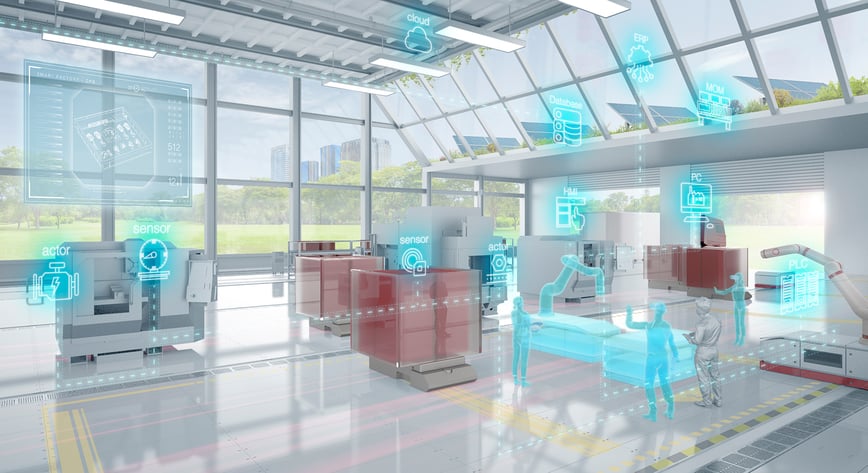Whether for planned maintenance or due to unplanned downtime - if the assembly lines are at a standstill and no cars can be produced, the company loses money. Predictive maintenance promises a solution: this is a method that helps to optimise maintenance intervals and detect incipient problems in good time, long before the machinery breaks down. One of the major vehicle manufacturers was interested in this concept as a means of further improving efficiency, and awarded EDAG a contract for its implementation. High-performance hardware was needed to be able to process large quantities of data with intelligent software; not, however, in the computer centre, but close to the machinery, in the network periphery. In cooperation with Dell Technologies, we developed an edge computing solution which in practical use more than proved its worth.
Time is money – this is particularly true in the automotive industry. Normally, the belts here run at full capacity, so it is not easy to make up for any disruptions in production. Accordingly, overall equipment effectiveness (OEE) depends to a high degree on the smooth running of the production plant. It is not simply a matter of avoiding unplanned downtimes; maintenance and optimisation work should also be carried out as infrequently as possible. But until recently, one of EDAG's major customers premises performed this work at fixed time intervals.
Predictive maintenance promises appreciable improvements in this area. Maintenance intervals are measured not by operating hours, but according to "equipment health". Provided that wear parts and materials are in good condition, there is no need to stop the machinery unnecessarily. To this end, it is necessary to collect extensive quantities of data that will show whether all relevant parameters are within the normal range. In this way, incipient problems can also be detected in good time.
Bearing damage in the power unit, for example, is indicated long before a breakdown by the way the power consumption creeps up. If this is noticed in time, thorough preparations can be made, and the part replaced in very little time, whereas if the machine suddenly stops, first of all, the reason needs to be found, and then there is no guarantee that a replacement unit and the required service personnel will be available at that precise moment.

The implementation of predictive maintenance places high demands on computing power and storage volume: large quantities of data from countless sensors and actuators provides information not only about the status of machines and systems, but also about the environment, for instance temperature and humidity. This flood of data has to be analysed by means of artificial intelligence, to find repetitive patterns and detect constant changes.
"Using intelligent technologies, our customer wanted to optimise the maintenance of its production facilities, and become considerably more efficient in terms of cost, quality and time," explains Mark Kramer, Head of Production IT (Smart Factory Solutions) at EDAG Production Solutions GmbH &Co. KG. Working for the engineering service provider, he is responsible for consulting, planning and implementing production IT. This includes the development of cyber-physical systems, manufacturing execution systems such as MES, big data solutions for production optimisation, quality management, real time information systems and predictive maintenance.
The first step was to decide what data was needed, how to acquire it, and then to understand what influence it has and how the different data interacts. In cooperation with technical experts, the EDAG engineers developed pertinent hypotheses which were then validated and became part of the data evaluation, is how Jacek Burger, project leader for embedded systems & artificial intelligence and software development expert at EDAG Engineering GmbH, describes the process for arriving at the AI models.

The size of the database and the intelligence and performance of the analysis algorithm are key factors in the quality of the knowledge gained. Accordingly, it is important to install powerful hardware. EDAG decided to employ an edge computing solution, i.e. a high performance IT infrastructure at the "edge" of the company. Such decentralised data processing in the periphery of the network and close to the data sources is characterised by lower latency periods, and also reduces the risk of disruptions in data communication.
The necessary infrastructure was a joint development by EDAG and Dell Technologies. The IT manufacturer offers an extensive portfolio of products and solutions for edge computing, which covers virtually any application. In addition to its storage and server hardware, Dell Technologies also has the expertise to provide and manage the IT infrastructure in accordance with individual user requirements: at the edge, but also in the computer centre or a hybrid cloud environment.
The edge solution is required to fit seamlessly into the corporate IT system - not act like a foreign body and increase complexity, which would be contrary to the goal of improving efficiency. Finally, the predictive maintenance solution was interfaced with all other systems, including logistics, PLP (product longevity program), MES (manufacturing execution system) and ERP (enterprise resource planning). "The challenges in this project were demanding, as the underlying software had to be individually developed. The customer's systems and infrastructure are very specialised, so wide-ranging expertise was required to coordinate the AI system and the hardware," expounded Kramer.

The pilot project did indeed achieve all the goals that the customer had expected from predictive maintenance. The planning of maintenance and service intervals was improved, and the use of service personnel reduced. There have since been fewer unplanned machine breakdowns, spare parts management has been optimised, and the analysis of the data collected has improved the understanding of the machines. As a result of the reduced downtimes, overall equipment effectiveness (OEE) rose by 2 percent.
"Although this might sound insignificant at first, such an improvement in OEE is outstanding in the automotive sector, which has already trimmed its processes to achieve maximum efficiency. Originally, we assumed the figure would be lower, so the customer is really very happy indeed," sums up Mark Kramer. The solution developed in the pilot project is now being rolled out to the customer's other plants and factories worldwide. At the same time, the practical experience gained is being channelled into the further development of the data analytics cluster.
If you, too, are interested in innovative solutions such as edge computing, artificial intelligence and machine learning, and in increasing the efficiency of your plant with intelligent applications, Mark Kramer will be happy to answer any questions you might have. Detailed information on our development concept can also be found in our free white paper "Edge Computing Brings AI into the Production Process".






